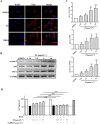Synthesis, target analysis, and cerebroprotective effects of novel imide antioxidants via the Nrf2/HO-1 pathway in cerebral ischemia-reperfusion injury
- PMID: 40385488
- PMCID: PMC12081345
- DOI: 10.3389/fphar.2025.1552717
Synthesis, target analysis, and cerebroprotective effects of novel imide antioxidants via the Nrf2/HO-1 pathway in cerebral ischemia-reperfusion injury
Abstract
Background: Cerebral ischemia-reperfusion injury (CIRI) is a secondary brain injury that occurs after thrombolysis and is a primary cause of death in ischemic stroke patients. Antioxidants that effectively reduce oxidative stress are an efficient treatment approach for CIRI. Here, a novel diimide compound was synthesized using the chemical structure of previously designed anti-inflammatory skeletons.
Methods and results: The antioxidant activities of five compounds (Z1-Z5) were preliminarily evaluated using the hydrogen peroxide-induced PC12 cell damage model, of which Z3 exhibited the best antioxidant effect, even exceeding that of the positive control (tert-butylhydroquinone). Enrichment analysis using network targeting and network pharmacology methods predicted seven candidate core target genes of Z3 in CIRI. Of these targets, computer molecular docking analysis predicted that Z3 has the strongest binding affinity for nuclear factor erythroid 2-related factor (Nrf2). MTT and colony formation assays, reactive oxygen species analysis, immunofluorescence, and immunoblotting experiments verified that Z3 reduced reactive oxygen species to play a protective antioxidant role via the Nrf2/hemoxygenase 1 (HO-1) pathway. The protective effect of Z3 in vivo was explored through TTC staining and neurobehavioral scoring of CIRI model mice.
Conclusion: This study provides a new drug development strategy and candidate drug for the treatment of CIRI, offering ideas for the design of new antioxidants.
Keywords: Nrf2 signaling pathway; antioxidant; cerebral ischemia-reperfusion injury; molecular docking; network pharmacology; oxidative stress.
Copyright © 2025 Huang, Chen, Zhou, Chen, Wu, Wu, Liu and Zheng.
Conflict of interest statement
The authors declare that the research was conducted in the absence of any commercial or financial relationships that could be construed as a potential conflict of interest.
Figures










Similar articles
-
Thymus quinquecostatus Celak. ameliorates cerebral ischemia-reperfusion injury via dual antioxidant actions: Activating Keap1/Nrf2/HO-1 signaling pathway and directly scavenging ROS.Phytomedicine. 2021 Oct;91:153673. doi: 10.1016/j.phymed.2021.153673. Epub 2021 Jul 31. Phytomedicine. 2021. PMID: 34416627
-
Dual Antioxidant DH-217 Mitigated Cerebral Ischemia-Reperfusion Injury by Targeting IKKβ/Nrf2/HO-1 Signal Axis.Neurochem Res. 2023 Feb;48(2):579-590. doi: 10.1007/s11064-022-03783-x. Epub 2022 Oct 15. Neurochem Res. 2023. PMID: 36243818
-
Edaravone dexborneol protects cerebral ischemia reperfusion injury through activating Nrf2/HO-1 signaling pathway in mice.Fundam Clin Pharmacol. 2022 Oct;36(5):790-800. doi: 10.1111/fcp.12782. Epub 2022 May 4. Fundam Clin Pharmacol. 2022. PMID: 35470467 Free PMC article.
-
Targeting PI3K/Akt in Cerebral Ischemia Reperfusion Injury Alleviation: From Signaling Networks to Targeted Therapy.Mol Neurobiol. 2024 Oct;61(10):7930-7949. doi: 10.1007/s12035-024-04039-1. Epub 2024 Mar 5. Mol Neurobiol. 2024. PMID: 38441860 Review.
-
Nuclear factor erythroid 2-related factor-mediated signaling alleviates ferroptosis during cerebral ischemia-reperfusion injury.Biomed Pharmacother. 2024 Nov;180:117513. doi: 10.1016/j.biopha.2024.117513. Epub 2024 Sep 27. Biomed Pharmacother. 2024. PMID: 39341075 Review.
Cited by
-
Purified Cornel Iridoid Glycosides Attenuated Oxidative Stress Induced by Cerebral Ischemia-Reperfusion Injury via Morroniside and Loganin Targeting Nrf2/NQO-1/HO-1 Signaling Pathway.Cells. 2025 Aug 6;14(15):1205. doi: 10.3390/cells14151205. Cells. 2025. PMID: 40801636 Free PMC article.
References
-
- Adamic K., Dunn M., Ingold K. U. (1969). Formation of diphenyl nitroxide in diphenylamine inhibited autoxidations. Can. J. Chem. 47 (2), 287–294. 10.1139/v69-040 - DOI
LinkOut - more resources
Full Text Sources

